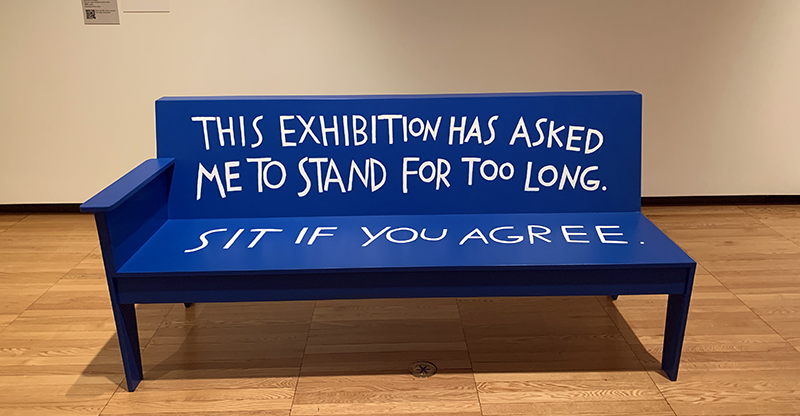The study of semiotics may sound like something that only happens in the hallowed halls of universities. But that’s just another myth we need to bust. Meaning making and value manufacturing are happening all around us, all of the time. And right now, there is no better place to consider them, and question them, than at Krannert Art Museum’s two recent exhibitions: Hal Fischer Photographs: Seriality, Sexuality, Semiotics, and Crip*. And while each of these important exhibitions are worthy of individual consideration here, viewing them together, as I did, yielded a richer and more complex exploration of the relationship between embodied identities and privileged spaces.
Let me say first that what is presented here is more preview, than review. More teaser than critique. Perhaps it is best considered an invitation, one from me, and one from Hal Fischer and the artists of Crip*, as well as the many scholars who have dedicated much time and thought to the curation and contextualizing of these works. One of the many perks of experiencing art in a university town is that when exhibitions come for a visit, they do not arrive alone. They come with opportunities for both academic and community engagement. And the spaces they embody is where change can be sown through conversation and questioning. And like the work it considers, this article centers the value of questioning over the arrival at simple answers.
In my consideration of these works, I found it useful to explore Fischer first, as his work documents an early era of gay history. Fischer, who received his BFA from Illinois in 1973, found much of his inspiration in the pre-AIDS years of San Francisco’s gay subcultures.
This vast installation covers a wide range of Fischer’s most significant work, beginning with previously unseen early work from his days in Urbana, to his most famous photographic series Gay Semiotics (1977), 18th near Castro St. x 24 (1978), Boy-Friends (1979), and Cheap Chic Homo (1979).
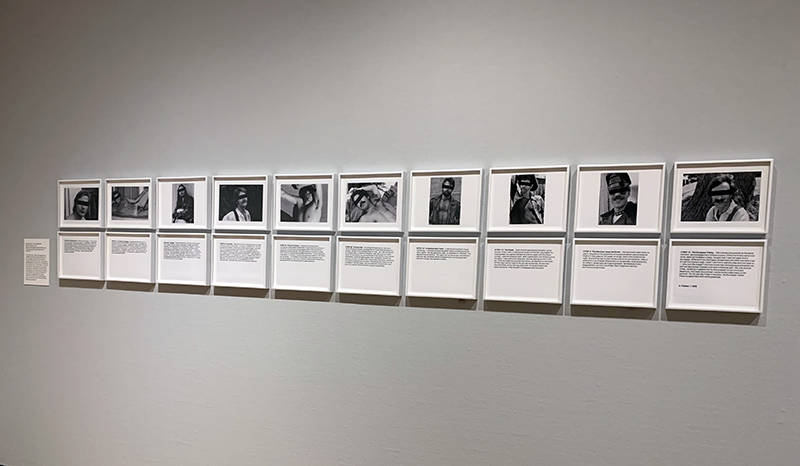
Photo by Debra Domal.
Experiencing Fischer’s iconic images through the lens of his early work, as the curator notes ” makes clear that Fischer’s concerns with portraiture, homoeroticism, formal experimentation, and the tensions between word and image, were present in nascent form at the start of his career. A retrospective view likewise amplifies the viewer’s appreciation of Fischer’s signature visual wit: his images of gay SM iconography document a sexual subculture while also provoking amusement.”
I found two works particularly interesting in that regard. In the trio of TV Images, we see a rare use of color and layering, which serve to deconstruct and reconstruct what we think we see.
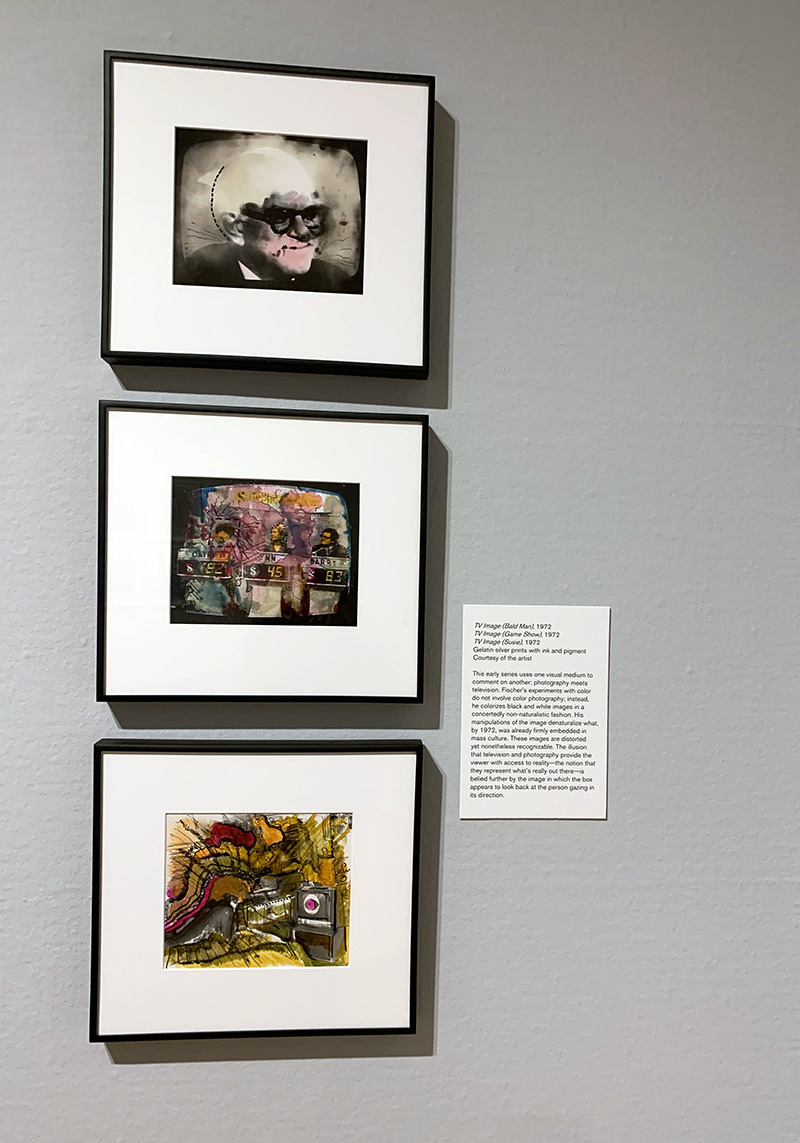
Photo by Debra Domal.
In “Robert in My Bathtub,” Fischer’s use of a classical, almost saintly pose, serves to shift the context and complicate the viewer’s reaction.
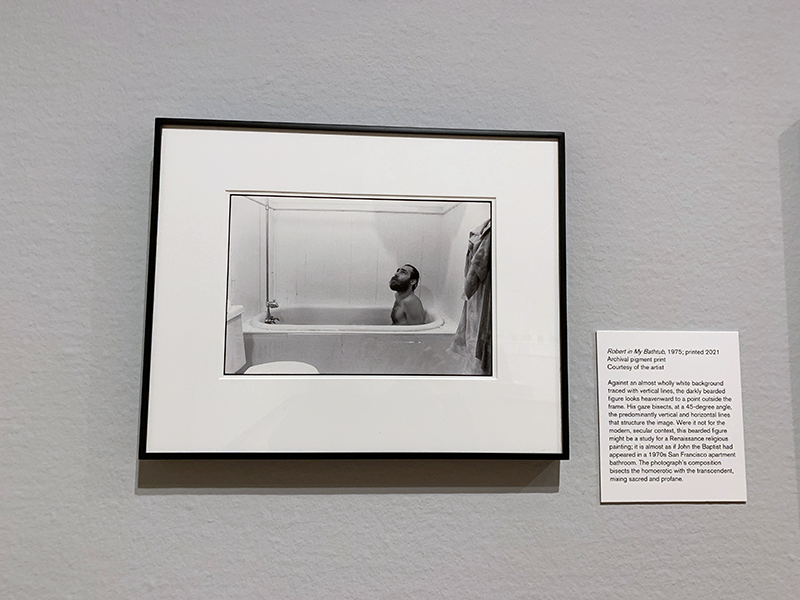
Photo by Debra Domal.
To consider “Gay Semiotics” in 2021 is to see the beginnings of gender studies as an artistic and academic subject. Its use of “subterranean codes and insignia of gay cruising are elevated, not without irony, to a comprehensive sign system.” Fischer “presents the photographer as an ethnographic explorer, cataloguing and decoding the mating rituals of a distinct urban tribe.”
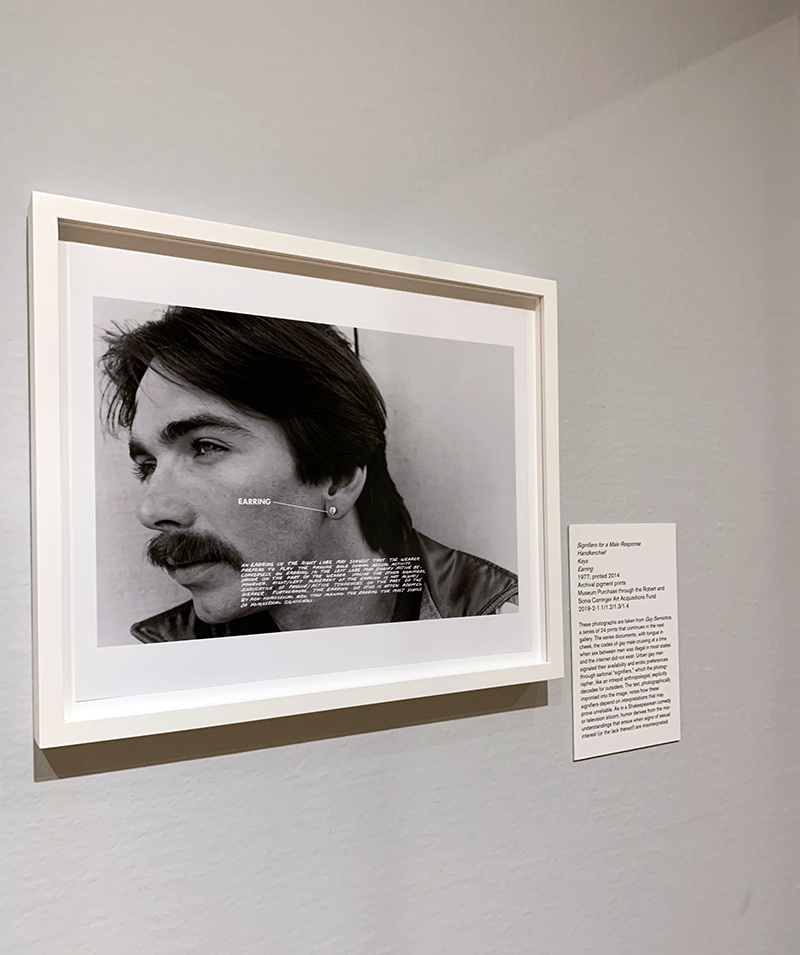
Photo by Debra Domal.
If you think you have seen these images, or images like them, before, it is Fischer you have to thank for blazing the trail. His models are neither (or perhaps both) outsiders and insiders, subjects and collaborators, objects of study and makers of meaning. While this blurring of the lines is evident in the ‘Boy-Friends” series seen above, its ironic ethnographic approach elevates works like “Signifiers: Handkerchief, Earring, Keys,” above, and “Archetypal Media Image Leather,” seen below, beyond audience shock value and into a sign or symbol system with which a dialgoue about gay identity could begin.
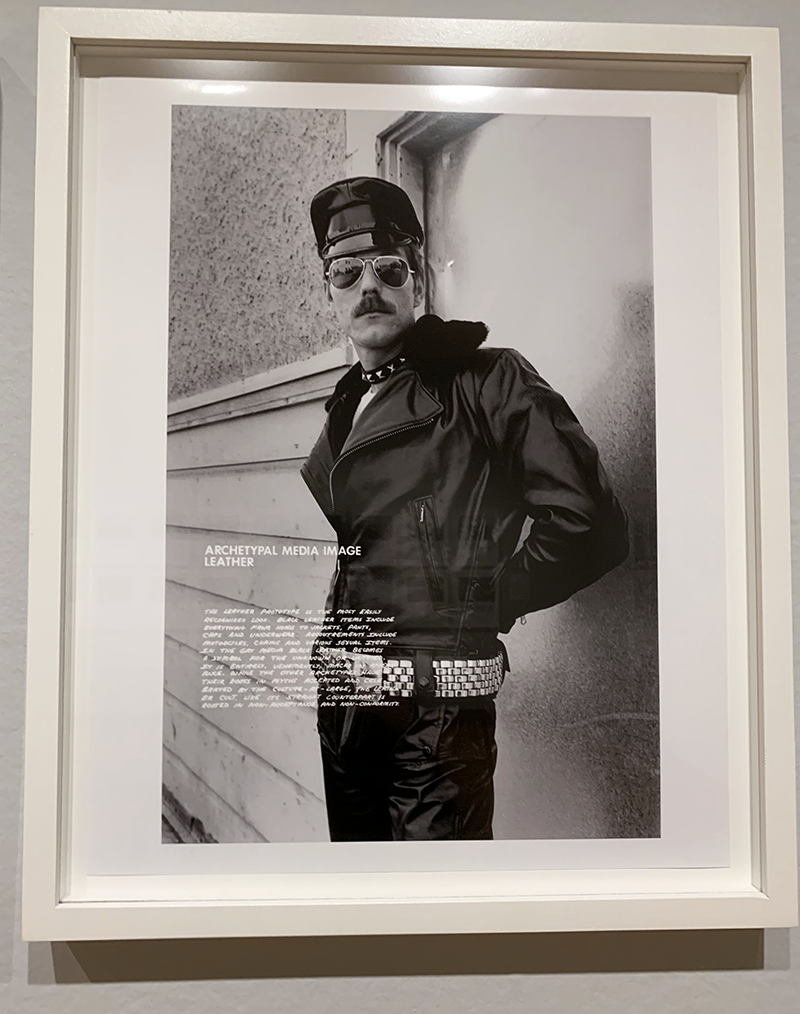
Photo by Debra Domal.
On the other side of the museum from Hal Fischer Photographs, you’ll find the immersive experience of Crip*, “a group exhibition featuring artists who address disability and intersectional thinking,” which asks:
“How do academic and cultural institutions inform awareness of disability? Who is responsible for access? And what happens when identities who have historically been excluded from art spaces begin to occupy these same spaces as artists?
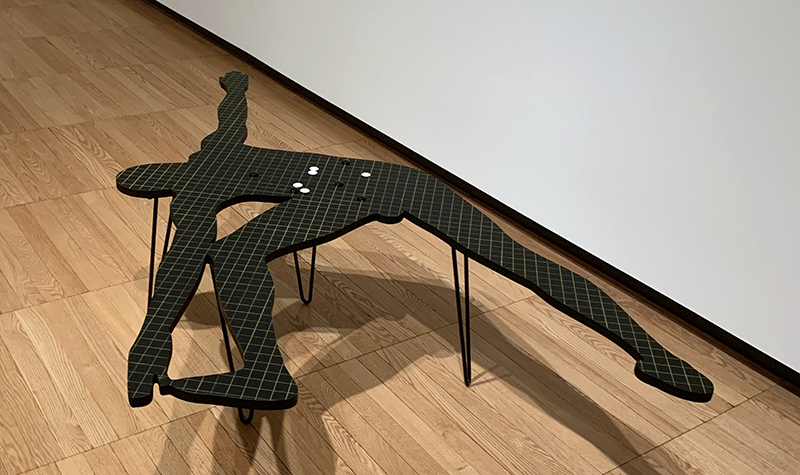
Photo by Debra Domal.
As much of its time as Fisher’s work, Crip* references Crip Theory, “which was coined by professor, writer, and theorist Robert McRuer in his book Crip Theory: Cultural Signs of Queerness and Disability, published in 2006.” McRuer’s work represents a groundbreaking approach to the investigations of embodied identities. Crip* embodies the reality that we live in a world whose very architecture favors certain bodies over others. Like Hal Fischer Photographs, it creates a space where the cultural script is flipped, and normalized bodies and identities are forced to confront their very privileges. The word “Crip” like the word “Queer” dismantles its painful past with a reclaiming of power, voice, and meaning making.
Crip Theory investigates and describes “how compulsory heteronormativity and compulsory able-bodiedness rely on non-normal bodies and identities to exist. Normativity is essentially held in place, and defined by, all of the things that “it is not.” Non-normative identities are shaped around and against normativity and are required to remain non-normative in order to preserve normative continuity. “
One might even say that Crip Theory queers earlier disability studies, which “theorized and constructed a somewhat singular disabled identity.” Instead it seeks to “utilize productive aspects of that identity while resisting its limitations, primarily to forge connections and networks across multiple identity distinctions.” The artists in Crip* “take on and push against rigid identity distinctions by presenting complicated works that resist reduction.”

Darrin Martin, Contrapposto, Video, 2016. @ Darrin Martin. Photo by Debra Domal.
By utilizing “a new vocabulary to articulate variations of ability and experience,” the artists of Crip* “delineate between the empowering and useful aspects of identity that facilitate dialogue and the constraining or limiting aspects that extinguish it. The exhibition thus fractures and reassembles how we think about identity within the framework of our culture “
Like Hal Fischer Photographs, Crip* makes waves, asking us to “redefine and question our own ingrained thinking about what it means to move through a world that both rejects and capitalizes on experiences that are not perceived as normal.” Crip* is part of a larger collaborative project, entitled “Cripping the Arts,” that also works to increase accessibility in art institutions.
And while this writer rarely suggests homework, in this case I will make an exception. For Crip* download and enjoy the following zines by Liz Barr, which investigate women’s bodies, notions of beauty and wellness through the lens of work. While you can glance at them during the installation, I found them worth a second or third read (before or after your visit) particularly in regard to “aspirational aesthetics and ideologies” and the “drive for self-actualization” through bodily manipulations. A quick trip to YouTube where you can watch Robert McRuer speak on the hows and whys of Crip theory is also well worth it. Finally, if you’re up for an extra credit assignment, I invite you to attend either or all of the upcoming colloquia surrounding these exhibitions where you can engage with Crip* curator Liza Sylvestre and the artists in Crip* as well as guest curator, Dr. Tim Dean, who serves as the James M. Benson Professor in English at the University of Illinois Urbana-Champaign.
Conditioner (2019) by Liz Barr
Hal Fischer Photographs: Seriality, Sexuality, Semiotics
Through December 22nd
Krannert Art Museum
500 E Peabody Dr, Champaign
Museum Hours: T-Sat, 10 a.m. to 4 p.m.
(Closed Sunday and Monday)
Symposium | Hal Fischer Photographs: Seriality, Sexuality, Semiotics
November 6th, 10 a.m. to 6 p.m.
Krannert Art Museum
Lower Level, Auditorium (KAM 62)
500 E Peabody Dr, Champaign
Crip*
Through December 11th
Krannert Art Museum
500 E Peabody Dr, Champaign
Museum Hours: T-Sat, 10 a.m. to 4 p.m.
(Closed Sunday and Monday)
Plan your visit here.
Crip* Colloquium
October 21st, 2 p.m. to 7 p.m.
October 22nd, 9 a.m. to 5 p.m.
Hybrid event: In-person at Siebel Center for Design
and virtual via Zoom
Learn more or register here.








